COINWORLD | By David Vagi, Special to Coin World | September 21, 2015
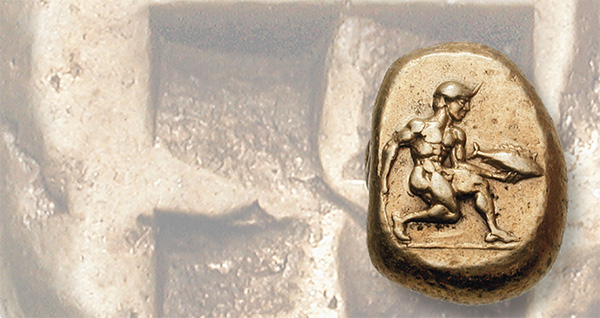
showing a young man advancing, holding a tunny and a curved knife.
Images courtesy of Classical Numismatic Group.
Cities still use alloy after switch to pure gold and silver
The story of the world’s first coins, seemingly introduced in the mid-seventh century B.C. and made of “white gold” electrum, is well known. This alloy of gold and silver earned its name from its pale yellow color, which resembled amber, called “electron” in Greek.
Though electrum was the exclusive metal for the earliest phase of coinage, by the end of the sixth century B.C. it largely had been supplanted by issues of pure gold and pure silver. Even so, the period of greatest production for electrum coinage in Asia Minor was from about the 520s to the 320s B.C. — exactly when one might have expected electrum coinage to have died out.
After this early period occasional, isolated issues of electrum emerged from a number of mints, which supplemented some extremely large issues from three cities in Asia Minor: Cyzicus, Phocaea and Mytilene. Remarkably, these cities found economic advantage in using electrum at a time when the rest of the Greek world had largely come to prefer silver or gold.
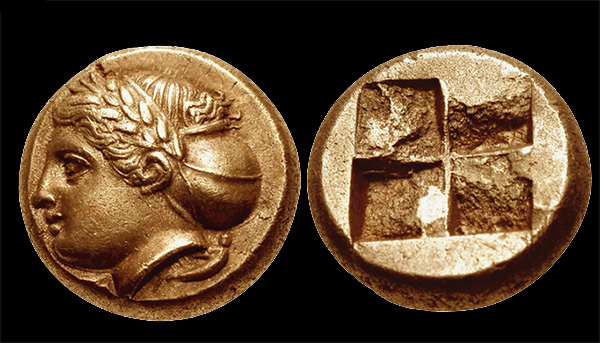
the obverse of this electrum hecte struck at Phocaea between about 387 and 326 B.C.
Images courtesy of Classical Numismatic Group.
The most important issuer of electrum coins in the Greek world was Cyzicus, a wealthy port on the southern shore of the Bosporus, the strait that links the Black Sea with the Aegean. Its ideal location allowed the city’s merchants to grow wealthy from their near-monopoly on trade between Greece and the distant shores of the Black Sea.
The principal trade coin of Cyzicus from the late seventh through the late fourth Century B.C. was the electrum stater. This coin of about 16 grams was widely accepted in commerce, and in ancient inscriptions it was often referred to by its familiar nickname “Cyzicene.” Although electrum fractional denominations were also produced at Cyzicus, they were for local or regional use, and seldom were exported.
Cyzicus made a purposefully archaic coinage: the planchets were thick and dumpy and the reverse had no artistic design, just the impression of a simple punch with a roughened surface.
Clearly this was the intent of the minters, who recognized that the hard-earned reputation of their “Cyzicenes” might be compromised if they were to modernize too much.
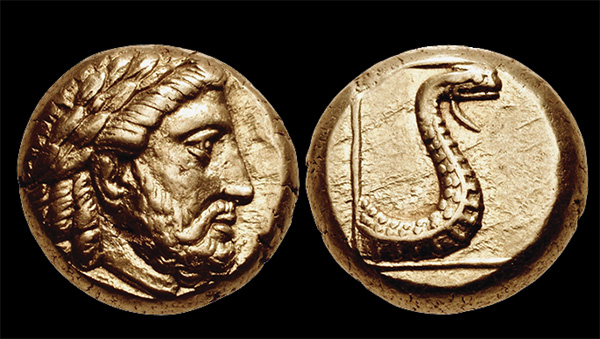
electrum hecte issued at Mytilene sometime between about 387 and 326 B.C.
Images courtesy of Classical Numismatic Group.
This coinage was remarkable in that it did not have a standard design, but instead was host to hundreds of different designs that usually were distinctive, and often were of great artistic merit. One exception aside, these coins also had no inscription that identified Cyzicus as the issuing authority. However, that hardly mattered since their appearance was so distinctive and the city badge, a tuna (“tunny”) fish, was incorporated into all of the designs.
The two other important issuers of electrum in Asia Minor were Phocaea and Mytilene, which issued very large quantities of an electrum one-sixth stater, called a hecte.
Though Phocaea had issued hectai since the late seventh or early sixth century B.C., in about 521 B.C. it came to an agreement with Mytilene by which they shared the minting of hectai, issuing them in alternating years. We are fortunate that a copy of their contract survives, as it clearly states the terms.
Their hectai had much in common with the electrum of Cyzicus because they did not have “standard” designs but were constantly introducing new ones. Even so, the function of this coinage was different than that of the staters of Cyzicus: rather than having an extensive, international range of circulation, these coins rarely left western Asia Minor, where they were a standard form of exchange.
Though the general appearance of the hectai of Phocaea and Mytilene was similar, they were distinct because the Phocaea hectai had an artistic design only on the obverse and those of Mytilene had artistic designs on both sides.
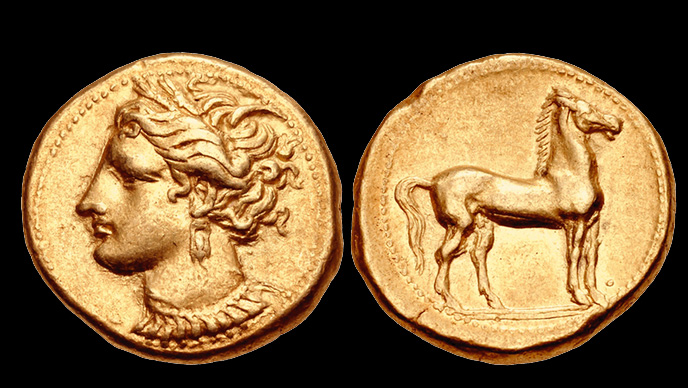
circa 320 to 270 B.C. It bears the head of the goddess Tanit and a standing horse.
Images courtesy of Classical Numismatic Group.
Also distinguishing them was the fact that Phocaea used a civic badge to supplement its ever-changing designs, whereas this did not occur at Mytilene. Phocaea’s badge was a seal — a play on words, for the name of that sea mammal in Greek is phoce, which approximates the city name. Just like Cyzicus, these two cities stopped striking electrum soon after the Macedonian King Alexander III “the Great” (336 to 323 B.C.) arrived in Asia Minor.
As the production of electrum coinage in Asia Minor died out in the 320s, it is most curious that the tradition was then taken up at the other end of the Mediterranean by Carthage, a Phoenician settlement on the shore of North Africa, just southwest of Sicily.
The earliest precious metal coins of Carthage, dating to about 350 B.C., were made of pure gold, but by about 320 B.C. they were substituted with staters of electrum.
These were issued in very large quantities, along with multiple and fractional denominations that were produced only occasionally and in relatively small quantities. The standard design for the Carthaginian stater was the head of the goddess Tanit and a standing horse.
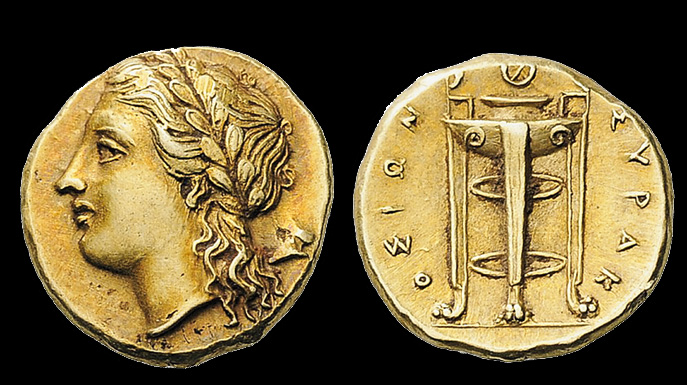
seemingly was valued at 50 or 25 litral. It shows the god Apollo and a tripod.
Images courtesy of Classical Numismatic Group.
They mainly appear to have been issued from circa 320 to 270 B.C. After that prolific era, Carthage also struck electrum coinage during its three wars with Rome: the First Punic War (264 to 241 B.C.), the Second Punic War (218 to 201 B.C.), and the Third Punic War (149 to 146 B.C.).
As a footnote, we should also describe the electrum issues of nearby Syracuse, the most powerful city on the island of Sicily. Impressive though they were, these coins were produced only during the reign of King Agathocles (317 to 289 B.C.). Indeed, it has been suggested that this unusual coinage was struck to repurpose electrum staters that Agathocles had collected from Carthage as booty or as a war indemnity.









